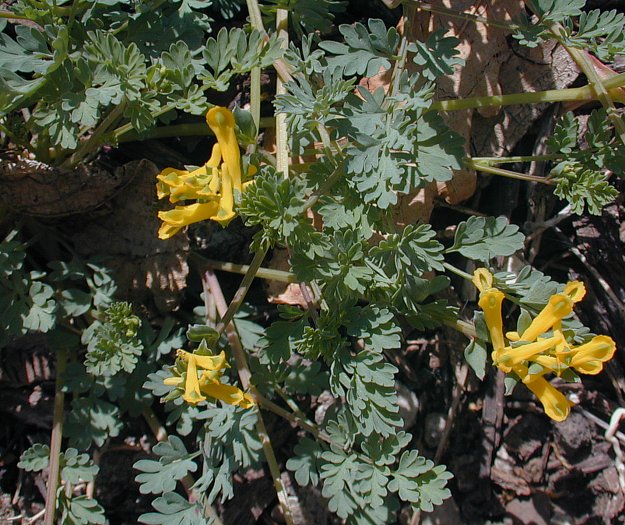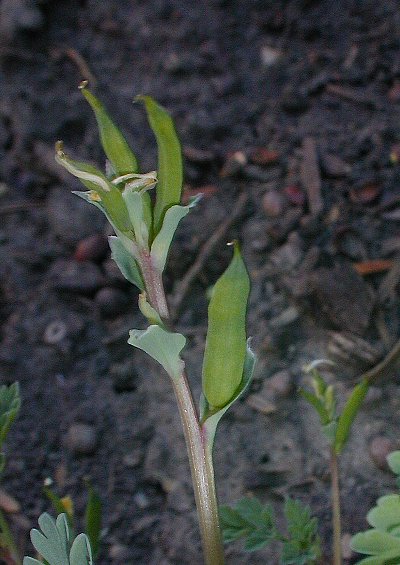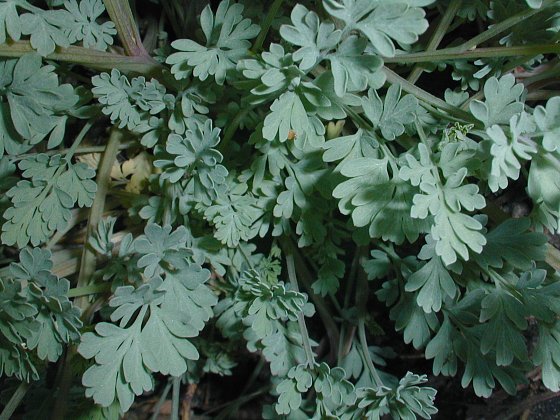Description: This plant is a winter or spring annual. A typical plant consists of a rosette of basal leaves about 8" across and several flowering stalks about 8" long. The blades of the basal leaves are up to 3" long and 2" across; they are pinnately compound, dull green to greyish blue, and hairless. The small lobes of the blades taper to obtuse points. The basal leaves have long slender petioles that are about as long as the blades. Alternate leaves occur along the flowering stalks. They are similar in appearance to the basal leaves, except that they are smaller in size and their petioles are shorter. The flowering stalks are are pale green to pale reddish green, hairless, and somewhat glaucous; they are sprawling, ascending, or erect. Each stalk terminates in a raceme of flowers up to 3" long. Each flower has a corolla consisting of 2 outer petals that are pale yellow to yellow and 2 inner petals that are more white and membranous. The upper outer petal forms a fringed upper lip in front and a rounded nectar spur in back; the top of the upper lip has a greenish yellow keel that may be slightly winged or crested. The lower outer petal forms a lower lip that functions as a landing pad for visiting insects; the bottom of the lower lip also has a greenish yellow keel that is similar to the upper keel. The inner petals are largely hidden by the outer petals, except when the flower is fully open; at that time, they are pale white or greenish yellow.

Each flower is about 1/3" to 1/2" (8-12 mm.) long and its pedicel is 1/4" (6 mm.) long or less. At the base of each pedicel, there is a single leafy bract up to 1/3" (8 mm.) long; this small bract is ovate or ovate-lanceolate. The blooming period occurs from mid- to late-spring, lasting about 1–1½ months. There is no noticeable floral scent. Each flower is replaced by a seedpod up to 2/3" (17 mm.) long. Each seedpod is dull green, hairless, slightly glaucous, and cylindrical in shape; several pale veins may be detectable that run along its length. The tip of each seedpod terminates in a beak. The surface of the seedpod between the seeds may be slightly constricted or unconstricted. Relative to the stalk of each raceme, the seedpods are erect or ascending, rather than widely spreading. The small seeds are about 1.0–1.5 mm. across, flattened, circular, shiny, and black. Fresh seeds have a small fleshy appendage that is white; this is an elaisome. The seedpods split open to release the seeds while they are still green. The root system consists of a slender taproot that branches abundantly. This plant spreads by reseeding itself.

Cultivation:
The preference is partial sun and moist to mesic conditions during the
period of active growth during the spring. This plant will grow in many
kinds of soil, but it is usually found in soil that contains sand or
rocky material; it also adapts to loamy soil containing abundant
organic matter and bark litter. The foliage gradually withers away
during the summer.
Range & Habitat:
The native Slender Corydalis is occasional in northern and western
Illinois, but
uncommon elsewhere in the state (see Distribution
Map). Habits include open rocky woodlands, sandy savannas,
ledges along thinly wooded bluffs, glades, gravelly areas along
railroads (including the ballast), and mulched areas along buildings.
Slender Corydalis prefers habitats with scant ground vegetation and a
little shade. Occasional wildfires are beneficial as they reduce
competition from woody vegetation and other plants.

Faunal
Associations:
The flowers are pollinated by long-tongued bees, particularly
bumblebees. An aphid, Macrosiphum
corydalis, sucks juices from the flowering stalks of Corydalis spp. The
seeds are distributed to some extent by ants because of their elaisomes
(food appendages). Mammalian herbivores avoid consumption of this plant
because of its toxic foliage.
Photographic Location:
A mulched area along a building on the campus of the University of
Illinois in Urbana, Illinois. At this location, Slender Corydalis was
growing wild, like a weed. Many of the plants are periodically uprooted
and destroyed by maintenance and grounds staff, but this species has
persisted at this site for a number of years.

Comments: Among the Corydalis spp. with yellow flowers in Illinois, Slender Corydalis has smaller than average flowers (about 1/3–1/2" or 8-12 mm. in length). Only Corydalis flavula (Pale Corydalis) has smaller flowers (about 1/4–1/3" or 6-8 mm. in length), while the others have larger flowers (about 1/2–1" or 12-25 mm. in length). Pale Corydalis also has longer pedicels (1/4–3/4" or 6-19 mm. in length) than Slender Corydalis. The foliage of Slender Corydalis has a similar appearance to other Corydalis spp., except the lobes of its pinnately compound leaves have tips that are more blunt than some of the others. A closely related subspecies is Corydalis micrantha australis (Prairie Corydalis). This latter subspecies has longer seedpods (about 2/3–4/3" or 17-34 mm. in length) and longer flowering stalks that extend beyond the foliage. Other Corydalis spp. differ from Slender Corydalis by having constricted or knobby seedpods that are less erect, and some Corydalis spp. have larger seeds (1.5–2.0 mm. across).